Ethics and Stakeholder Analysis in Project Management - UTS 31272
VerifiedAdded on 2023/06/14
|14
|3301
|450
Report
AI Summary
This report examines the ethical considerations and stakeholder analysis surrounding the use of drone technology in project management, focusing on a case study involving the delivery of medical supplies. It identifies key stakeholders, including government bodies, drone manufacturers, companies utilizing drone technology, and human resources, and discusses three ethical issues: restrictive drone legislation, the displacement of human labor, and technical challenges. The report also explores different ethical principles applicable to each stakeholder group, such as universalism, deontology, relativism, and justice ethics, and provides a personal reflection on these issues. Furthermore, it briefly mentions the evaluation of code of ethics of government bodies associated with drone technology. This assignment offers an overview of the ethical dilemmas and stakeholder considerations in the context of emerging technologies, with the website Desklib providing past papers and solved assignments for students.
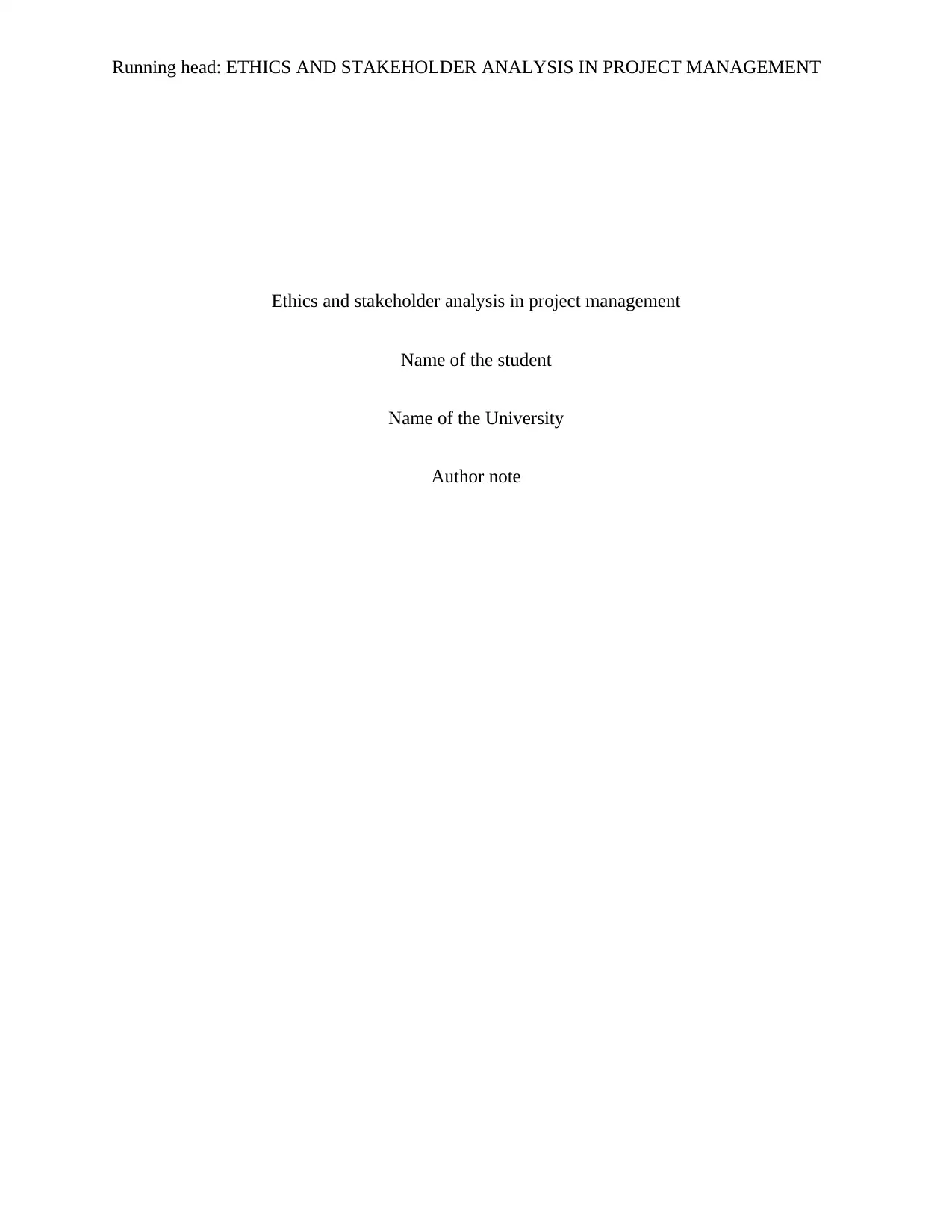
Running head: ETHICS AND STAKEHOLDER ANALYSIS IN PROJECT MANAGEMENT
Ethics and stakeholder analysis in project management
Name of the student
Name of the University
Author note
Ethics and stakeholder analysis in project management
Name of the student
Name of the University
Author note
Secure Best Marks with AI Grader
Need help grading? Try our AI Grader for instant feedback on your assignments.
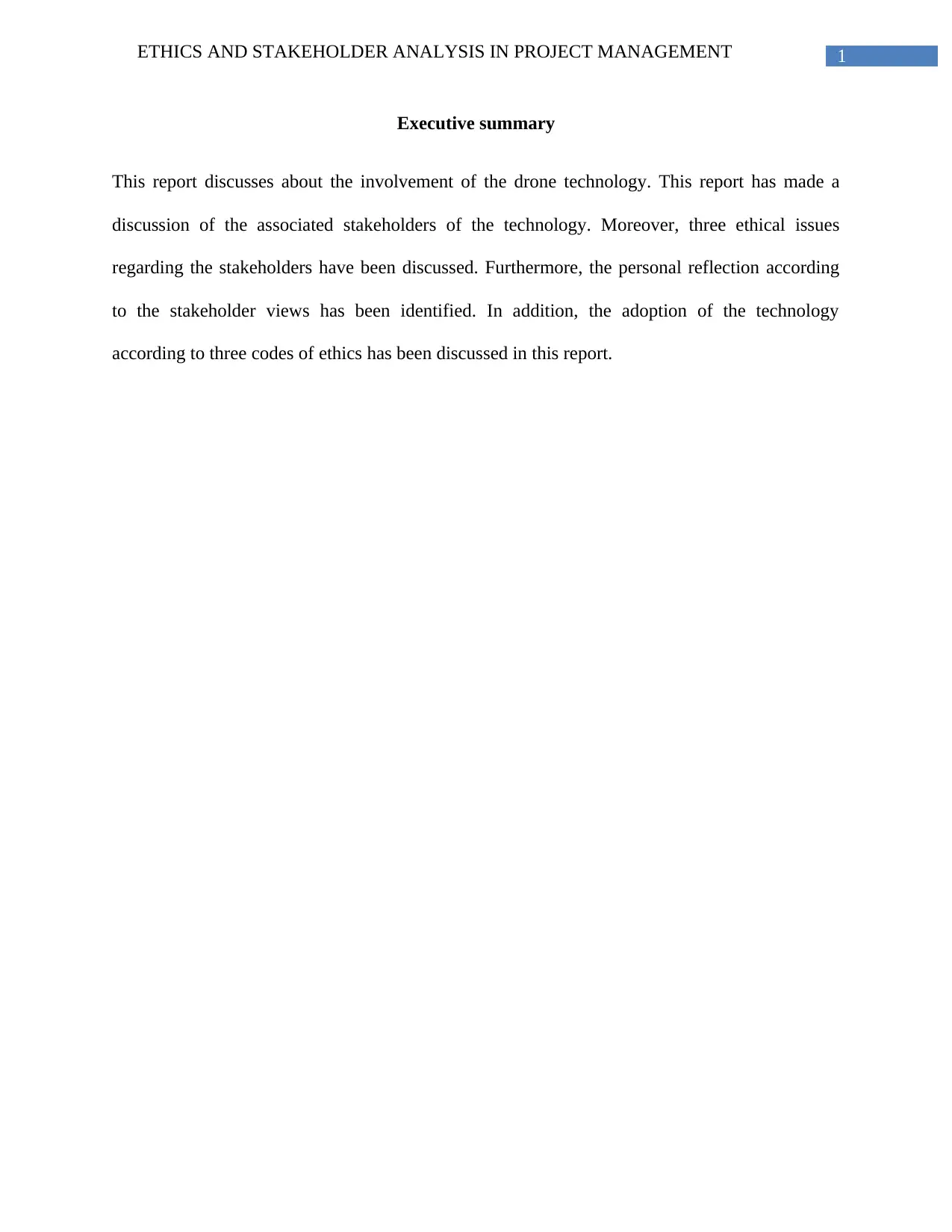
1ETHICS AND STAKEHOLDER ANALYSIS IN PROJECT MANAGEMENT
Executive summary
This report discusses about the involvement of the drone technology. This report has made a
discussion of the associated stakeholders of the technology. Moreover, three ethical issues
regarding the stakeholders have been discussed. Furthermore, the personal reflection according
to the stakeholder views has been identified. In addition, the adoption of the technology
according to three codes of ethics has been discussed in this report.
Executive summary
This report discusses about the involvement of the drone technology. This report has made a
discussion of the associated stakeholders of the technology. Moreover, three ethical issues
regarding the stakeholders have been discussed. Furthermore, the personal reflection according
to the stakeholder views has been identified. In addition, the adoption of the technology
according to three codes of ethics has been discussed in this report.
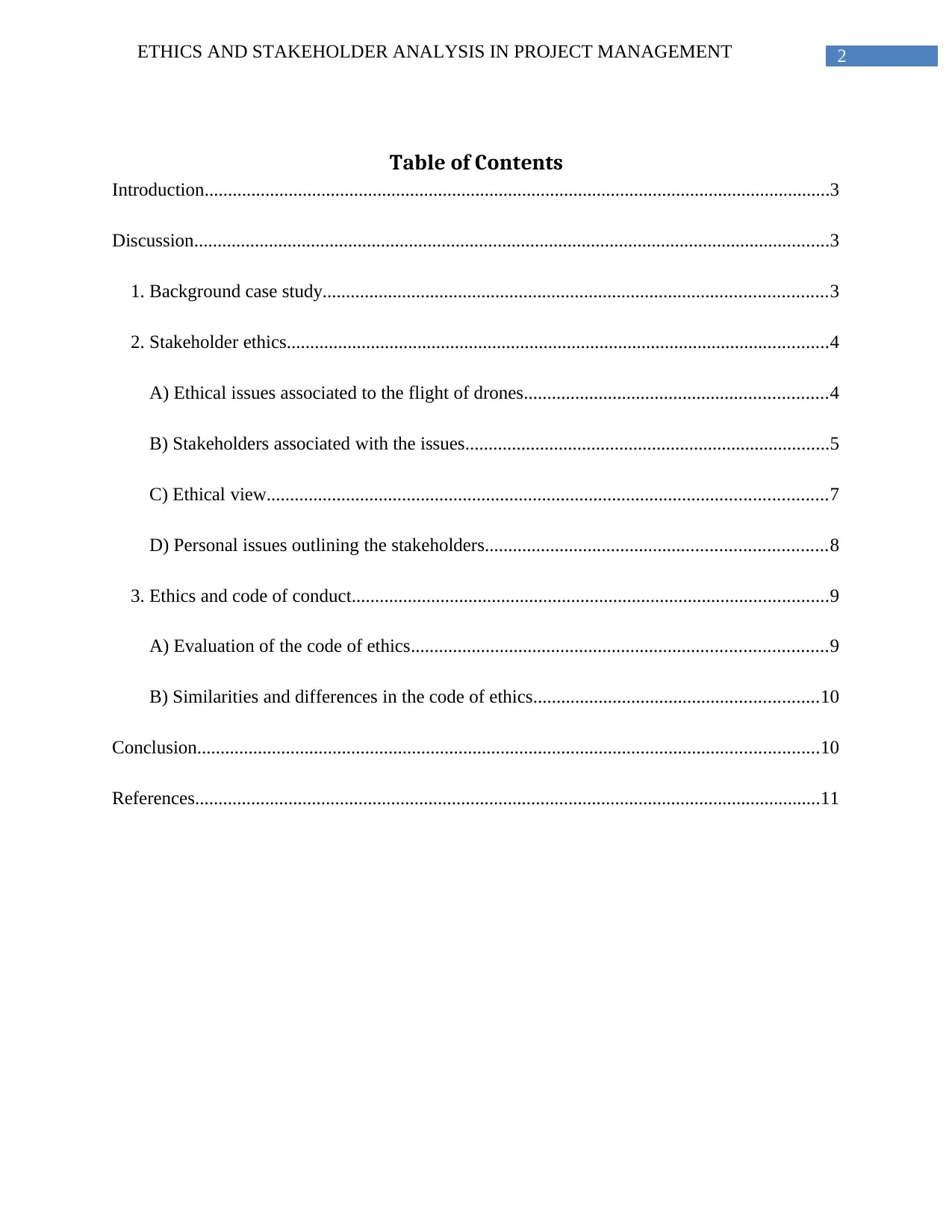
2ETHICS AND STAKEHOLDER ANALYSIS IN PROJECT MANAGEMENT
Table of Contents
Introduction......................................................................................................................................3
Discussion........................................................................................................................................3
1. Background case study............................................................................................................3
2. Stakeholder ethics....................................................................................................................4
A) Ethical issues associated to the flight of drones.................................................................4
B) Stakeholders associated with the issues..............................................................................5
C) Ethical view........................................................................................................................7
D) Personal issues outlining the stakeholders.........................................................................8
3. Ethics and code of conduct......................................................................................................9
A) Evaluation of the code of ethics.........................................................................................9
B) Similarities and differences in the code of ethics.............................................................10
Conclusion.....................................................................................................................................10
References......................................................................................................................................11
Table of Contents
Introduction......................................................................................................................................3
Discussion........................................................................................................................................3
1. Background case study............................................................................................................3
2. Stakeholder ethics....................................................................................................................4
A) Ethical issues associated to the flight of drones.................................................................4
B) Stakeholders associated with the issues..............................................................................5
C) Ethical view........................................................................................................................7
D) Personal issues outlining the stakeholders.........................................................................8
3. Ethics and code of conduct......................................................................................................9
A) Evaluation of the code of ethics.........................................................................................9
B) Similarities and differences in the code of ethics.............................................................10
Conclusion.....................................................................................................................................10
References......................................................................................................................................11
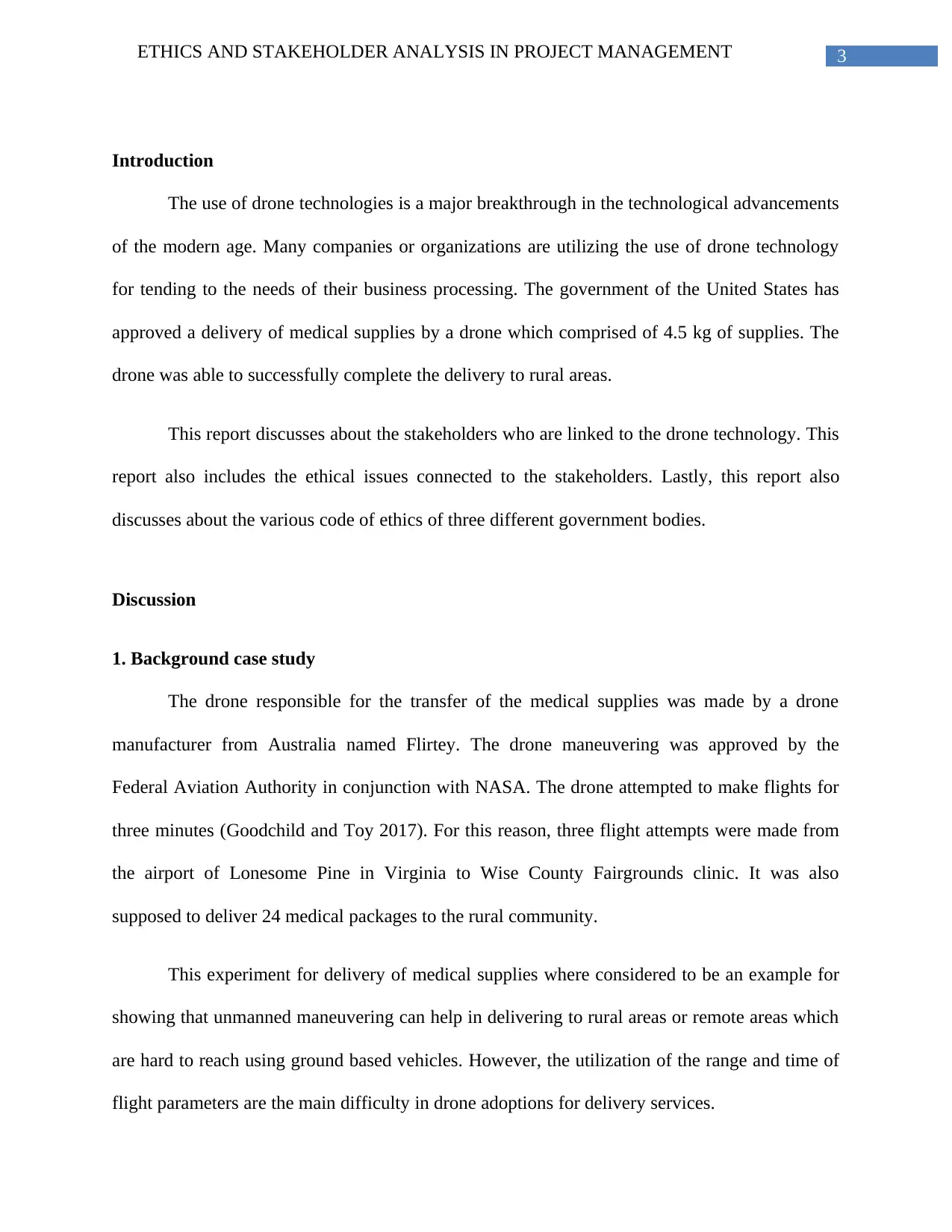
3ETHICS AND STAKEHOLDER ANALYSIS IN PROJECT MANAGEMENT
Introduction
The use of drone technologies is a major breakthrough in the technological advancements
of the modern age. Many companies or organizations are utilizing the use of drone technology
for tending to the needs of their business processing. The government of the United States has
approved a delivery of medical supplies by a drone which comprised of 4.5 kg of supplies. The
drone was able to successfully complete the delivery to rural areas.
This report discusses about the stakeholders who are linked to the drone technology. This
report also includes the ethical issues connected to the stakeholders. Lastly, this report also
discusses about the various code of ethics of three different government bodies.
Discussion
1. Background case study
The drone responsible for the transfer of the medical supplies was made by a drone
manufacturer from Australia named Flirtey. The drone maneuvering was approved by the
Federal Aviation Authority in conjunction with NASA. The drone attempted to make flights for
three minutes (Goodchild and Toy 2017). For this reason, three flight attempts were made from
the airport of Lonesome Pine in Virginia to Wise County Fairgrounds clinic. It was also
supposed to deliver 24 medical packages to the rural community.
This experiment for delivery of medical supplies where considered to be an example for
showing that unmanned maneuvering can help in delivering to rural areas or remote areas which
are hard to reach using ground based vehicles. However, the utilization of the range and time of
flight parameters are the main difficulty in drone adoptions for delivery services.
Introduction
The use of drone technologies is a major breakthrough in the technological advancements
of the modern age. Many companies or organizations are utilizing the use of drone technology
for tending to the needs of their business processing. The government of the United States has
approved a delivery of medical supplies by a drone which comprised of 4.5 kg of supplies. The
drone was able to successfully complete the delivery to rural areas.
This report discusses about the stakeholders who are linked to the drone technology. This
report also includes the ethical issues connected to the stakeholders. Lastly, this report also
discusses about the various code of ethics of three different government bodies.
Discussion
1. Background case study
The drone responsible for the transfer of the medical supplies was made by a drone
manufacturer from Australia named Flirtey. The drone maneuvering was approved by the
Federal Aviation Authority in conjunction with NASA. The drone attempted to make flights for
three minutes (Goodchild and Toy 2017). For this reason, three flight attempts were made from
the airport of Lonesome Pine in Virginia to Wise County Fairgrounds clinic. It was also
supposed to deliver 24 medical packages to the rural community.
This experiment for delivery of medical supplies where considered to be an example for
showing that unmanned maneuvering can help in delivering to rural areas or remote areas which
are hard to reach using ground based vehicles. However, the utilization of the range and time of
flight parameters are the main difficulty in drone adoptions for delivery services.
Secure Best Marks with AI Grader
Need help grading? Try our AI Grader for instant feedback on your assignments.
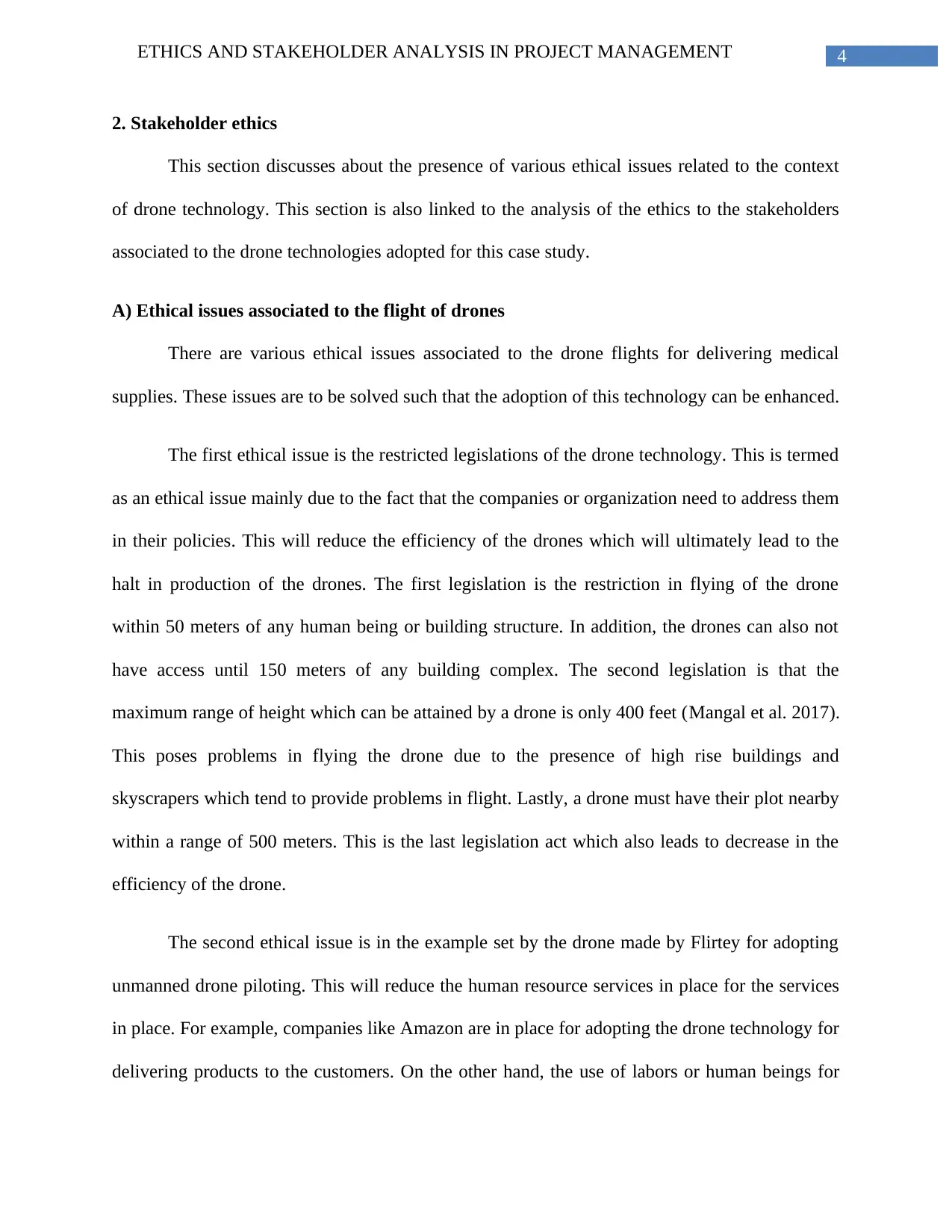
4ETHICS AND STAKEHOLDER ANALYSIS IN PROJECT MANAGEMENT
2. Stakeholder ethics
This section discusses about the presence of various ethical issues related to the context
of drone technology. This section is also linked to the analysis of the ethics to the stakeholders
associated to the drone technologies adopted for this case study.
A) Ethical issues associated to the flight of drones
There are various ethical issues associated to the drone flights for delivering medical
supplies. These issues are to be solved such that the adoption of this technology can be enhanced.
The first ethical issue is the restricted legislations of the drone technology. This is termed
as an ethical issue mainly due to the fact that the companies or organization need to address them
in their policies. This will reduce the efficiency of the drones which will ultimately lead to the
halt in production of the drones. The first legislation is the restriction in flying of the drone
within 50 meters of any human being or building structure. In addition, the drones can also not
have access until 150 meters of any building complex. The second legislation is that the
maximum range of height which can be attained by a drone is only 400 feet (Mangal et al. 2017).
This poses problems in flying the drone due to the presence of high rise buildings and
skyscrapers which tend to provide problems in flight. Lastly, a drone must have their plot nearby
within a range of 500 meters. This is the last legislation act which also leads to decrease in the
efficiency of the drone.
The second ethical issue is in the example set by the drone made by Flirtey for adopting
unmanned drone piloting. This will reduce the human resource services in place for the services
in place. For example, companies like Amazon are in place for adopting the drone technology for
delivering products to the customers. On the other hand, the use of labors or human beings for
2. Stakeholder ethics
This section discusses about the presence of various ethical issues related to the context
of drone technology. This section is also linked to the analysis of the ethics to the stakeholders
associated to the drone technologies adopted for this case study.
A) Ethical issues associated to the flight of drones
There are various ethical issues associated to the drone flights for delivering medical
supplies. These issues are to be solved such that the adoption of this technology can be enhanced.
The first ethical issue is the restricted legislations of the drone technology. This is termed
as an ethical issue mainly due to the fact that the companies or organization need to address them
in their policies. This will reduce the efficiency of the drones which will ultimately lead to the
halt in production of the drones. The first legislation is the restriction in flying of the drone
within 50 meters of any human being or building structure. In addition, the drones can also not
have access until 150 meters of any building complex. The second legislation is that the
maximum range of height which can be attained by a drone is only 400 feet (Mangal et al. 2017).
This poses problems in flying the drone due to the presence of high rise buildings and
skyscrapers which tend to provide problems in flight. Lastly, a drone must have their plot nearby
within a range of 500 meters. This is the last legislation act which also leads to decrease in the
efficiency of the drone.
The second ethical issue is in the example set by the drone made by Flirtey for adopting
unmanned drone piloting. This will reduce the human resource services in place for the services
in place. For example, companies like Amazon are in place for adopting the drone technology for
delivering products to the customers. On the other hand, the use of labors or human beings for
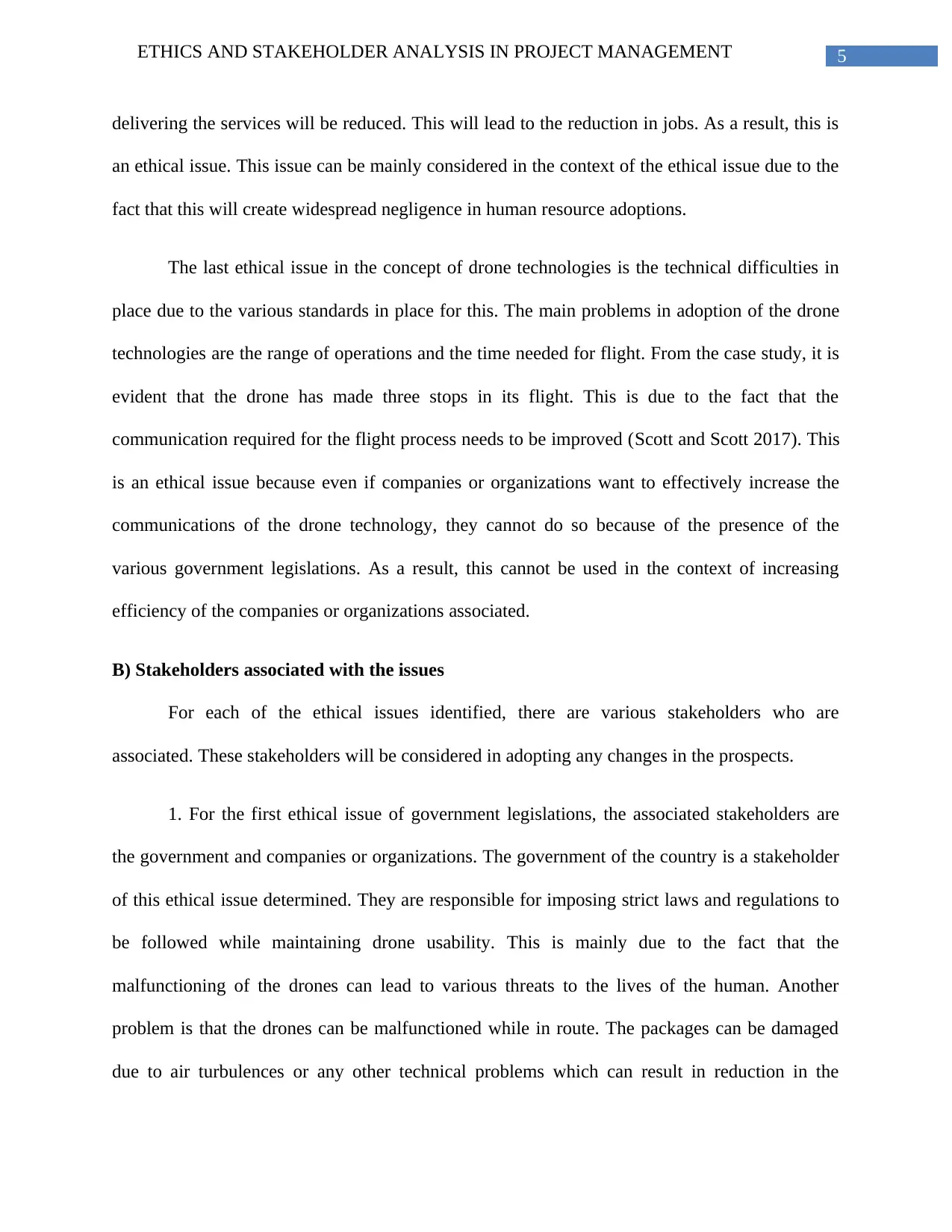
5ETHICS AND STAKEHOLDER ANALYSIS IN PROJECT MANAGEMENT
delivering the services will be reduced. This will lead to the reduction in jobs. As a result, this is
an ethical issue. This issue can be mainly considered in the context of the ethical issue due to the
fact that this will create widespread negligence in human resource adoptions.
The last ethical issue in the concept of drone technologies is the technical difficulties in
place due to the various standards in place for this. The main problems in adoption of the drone
technologies are the range of operations and the time needed for flight. From the case study, it is
evident that the drone has made three stops in its flight. This is due to the fact that the
communication required for the flight process needs to be improved (Scott and Scott 2017). This
is an ethical issue because even if companies or organizations want to effectively increase the
communications of the drone technology, they cannot do so because of the presence of the
various government legislations. As a result, this cannot be used in the context of increasing
efficiency of the companies or organizations associated.
B) Stakeholders associated with the issues
For each of the ethical issues identified, there are various stakeholders who are
associated. These stakeholders will be considered in adopting any changes in the prospects.
1. For the first ethical issue of government legislations, the associated stakeholders are
the government and companies or organizations. The government of the country is a stakeholder
of this ethical issue determined. They are responsible for imposing strict laws and regulations to
be followed while maintaining drone usability. This is mainly due to the fact that the
malfunctioning of the drones can lead to various threats to the lives of the human. Another
problem is that the drones can be malfunctioned while in route. The packages can be damaged
due to air turbulences or any other technical problems which can result in reduction in the
delivering the services will be reduced. This will lead to the reduction in jobs. As a result, this is
an ethical issue. This issue can be mainly considered in the context of the ethical issue due to the
fact that this will create widespread negligence in human resource adoptions.
The last ethical issue in the concept of drone technologies is the technical difficulties in
place due to the various standards in place for this. The main problems in adoption of the drone
technologies are the range of operations and the time needed for flight. From the case study, it is
evident that the drone has made three stops in its flight. This is due to the fact that the
communication required for the flight process needs to be improved (Scott and Scott 2017). This
is an ethical issue because even if companies or organizations want to effectively increase the
communications of the drone technology, they cannot do so because of the presence of the
various government legislations. As a result, this cannot be used in the context of increasing
efficiency of the companies or organizations associated.
B) Stakeholders associated with the issues
For each of the ethical issues identified, there are various stakeholders who are
associated. These stakeholders will be considered in adopting any changes in the prospects.
1. For the first ethical issue of government legislations, the associated stakeholders are
the government and companies or organizations. The government of the country is a stakeholder
of this ethical issue determined. They are responsible for imposing strict laws and regulations to
be followed while maintaining drone usability. This is mainly due to the fact that the
malfunctioning of the drones can lead to various threats to the lives of the human. Another
problem is that the drones can be malfunctioned while in route. The packages can be damaged
due to air turbulences or any other technical problems which can result in reduction in the
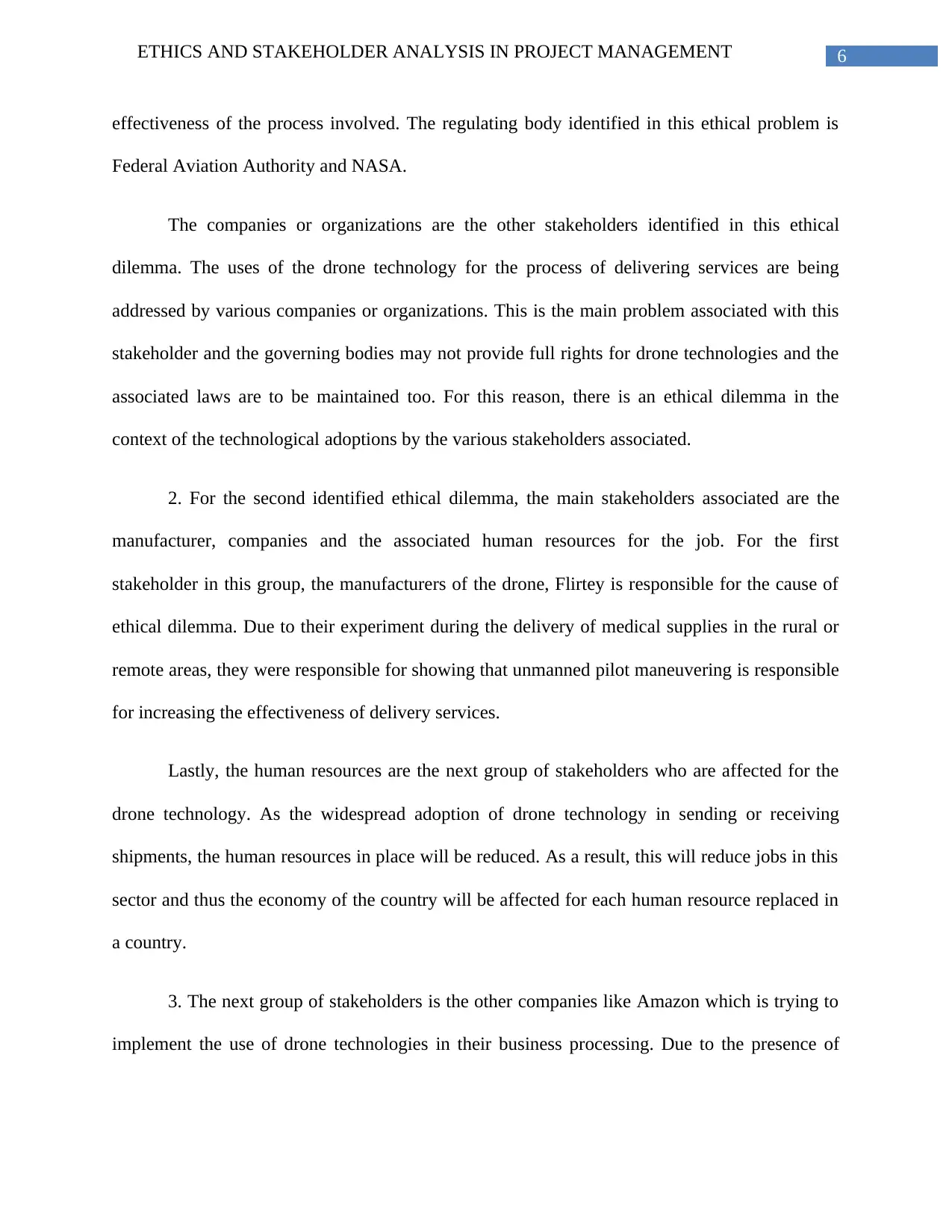
6ETHICS AND STAKEHOLDER ANALYSIS IN PROJECT MANAGEMENT
effectiveness of the process involved. The regulating body identified in this ethical problem is
Federal Aviation Authority and NASA.
The companies or organizations are the other stakeholders identified in this ethical
dilemma. The uses of the drone technology for the process of delivering services are being
addressed by various companies or organizations. This is the main problem associated with this
stakeholder and the governing bodies may not provide full rights for drone technologies and the
associated laws are to be maintained too. For this reason, there is an ethical dilemma in the
context of the technological adoptions by the various stakeholders associated.
2. For the second identified ethical dilemma, the main stakeholders associated are the
manufacturer, companies and the associated human resources for the job. For the first
stakeholder in this group, the manufacturers of the drone, Flirtey is responsible for the cause of
ethical dilemma. Due to their experiment during the delivery of medical supplies in the rural or
remote areas, they were responsible for showing that unmanned pilot maneuvering is responsible
for increasing the effectiveness of delivery services.
Lastly, the human resources are the next group of stakeholders who are affected for the
drone technology. As the widespread adoption of drone technology in sending or receiving
shipments, the human resources in place will be reduced. As a result, this will reduce jobs in this
sector and thus the economy of the country will be affected for each human resource replaced in
a country.
3. The next group of stakeholders is the other companies like Amazon which is trying to
implement the use of drone technologies in their business processing. Due to the presence of
effectiveness of the process involved. The regulating body identified in this ethical problem is
Federal Aviation Authority and NASA.
The companies or organizations are the other stakeholders identified in this ethical
dilemma. The uses of the drone technology for the process of delivering services are being
addressed by various companies or organizations. This is the main problem associated with this
stakeholder and the governing bodies may not provide full rights for drone technologies and the
associated laws are to be maintained too. For this reason, there is an ethical dilemma in the
context of the technological adoptions by the various stakeholders associated.
2. For the second identified ethical dilemma, the main stakeholders associated are the
manufacturer, companies and the associated human resources for the job. For the first
stakeholder in this group, the manufacturers of the drone, Flirtey is responsible for the cause of
ethical dilemma. Due to their experiment during the delivery of medical supplies in the rural or
remote areas, they were responsible for showing that unmanned pilot maneuvering is responsible
for increasing the effectiveness of delivery services.
Lastly, the human resources are the next group of stakeholders who are affected for the
drone technology. As the widespread adoption of drone technology in sending or receiving
shipments, the human resources in place will be reduced. As a result, this will reduce jobs in this
sector and thus the economy of the country will be affected for each human resource replaced in
a country.
3. The next group of stakeholders is the other companies like Amazon which is trying to
implement the use of drone technologies in their business processing. Due to the presence of
Paraphrase This Document
Need a fresh take? Get an instant paraphrase of this document with our AI Paraphraser
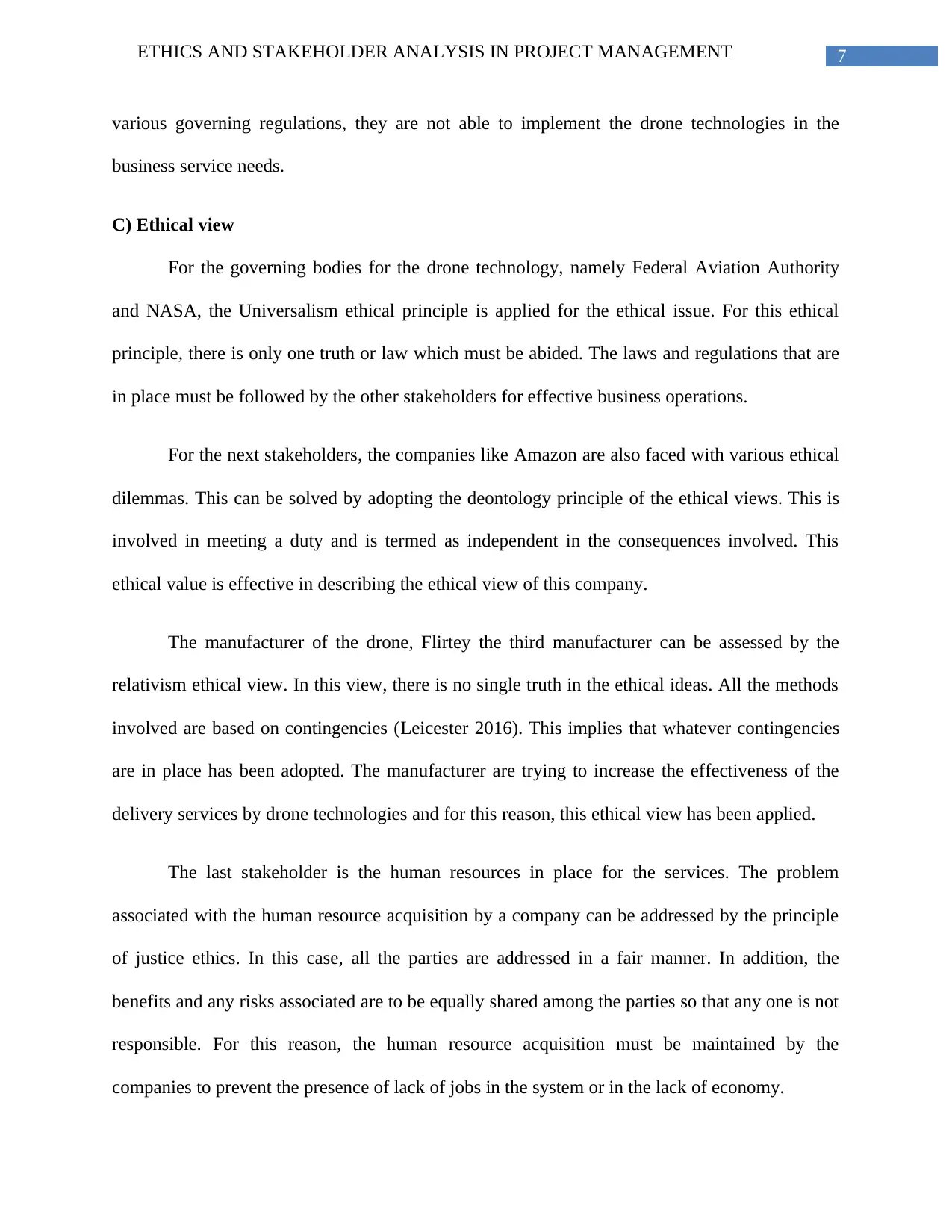
7ETHICS AND STAKEHOLDER ANALYSIS IN PROJECT MANAGEMENT
various governing regulations, they are not able to implement the drone technologies in the
business service needs.
C) Ethical view
For the governing bodies for the drone technology, namely Federal Aviation Authority
and NASA, the Universalism ethical principle is applied for the ethical issue. For this ethical
principle, there is only one truth or law which must be abided. The laws and regulations that are
in place must be followed by the other stakeholders for effective business operations.
For the next stakeholders, the companies like Amazon are also faced with various ethical
dilemmas. This can be solved by adopting the deontology principle of the ethical views. This is
involved in meeting a duty and is termed as independent in the consequences involved. This
ethical value is effective in describing the ethical view of this company.
The manufacturer of the drone, Flirtey the third manufacturer can be assessed by the
relativism ethical view. In this view, there is no single truth in the ethical ideas. All the methods
involved are based on contingencies (Leicester 2016). This implies that whatever contingencies
are in place has been adopted. The manufacturer are trying to increase the effectiveness of the
delivery services by drone technologies and for this reason, this ethical view has been applied.
The last stakeholder is the human resources in place for the services. The problem
associated with the human resource acquisition by a company can be addressed by the principle
of justice ethics. In this case, all the parties are addressed in a fair manner. In addition, the
benefits and any risks associated are to be equally shared among the parties so that any one is not
responsible. For this reason, the human resource acquisition must be maintained by the
companies to prevent the presence of lack of jobs in the system or in the lack of economy.
various governing regulations, they are not able to implement the drone technologies in the
business service needs.
C) Ethical view
For the governing bodies for the drone technology, namely Federal Aviation Authority
and NASA, the Universalism ethical principle is applied for the ethical issue. For this ethical
principle, there is only one truth or law which must be abided. The laws and regulations that are
in place must be followed by the other stakeholders for effective business operations.
For the next stakeholders, the companies like Amazon are also faced with various ethical
dilemmas. This can be solved by adopting the deontology principle of the ethical views. This is
involved in meeting a duty and is termed as independent in the consequences involved. This
ethical value is effective in describing the ethical view of this company.
The manufacturer of the drone, Flirtey the third manufacturer can be assessed by the
relativism ethical view. In this view, there is no single truth in the ethical ideas. All the methods
involved are based on contingencies (Leicester 2016). This implies that whatever contingencies
are in place has been adopted. The manufacturer are trying to increase the effectiveness of the
delivery services by drone technologies and for this reason, this ethical view has been applied.
The last stakeholder is the human resources in place for the services. The problem
associated with the human resource acquisition by a company can be addressed by the principle
of justice ethics. In this case, all the parties are addressed in a fair manner. In addition, the
benefits and any risks associated are to be equally shared among the parties so that any one is not
responsible. For this reason, the human resource acquisition must be maintained by the
companies to prevent the presence of lack of jobs in the system or in the lack of economy.
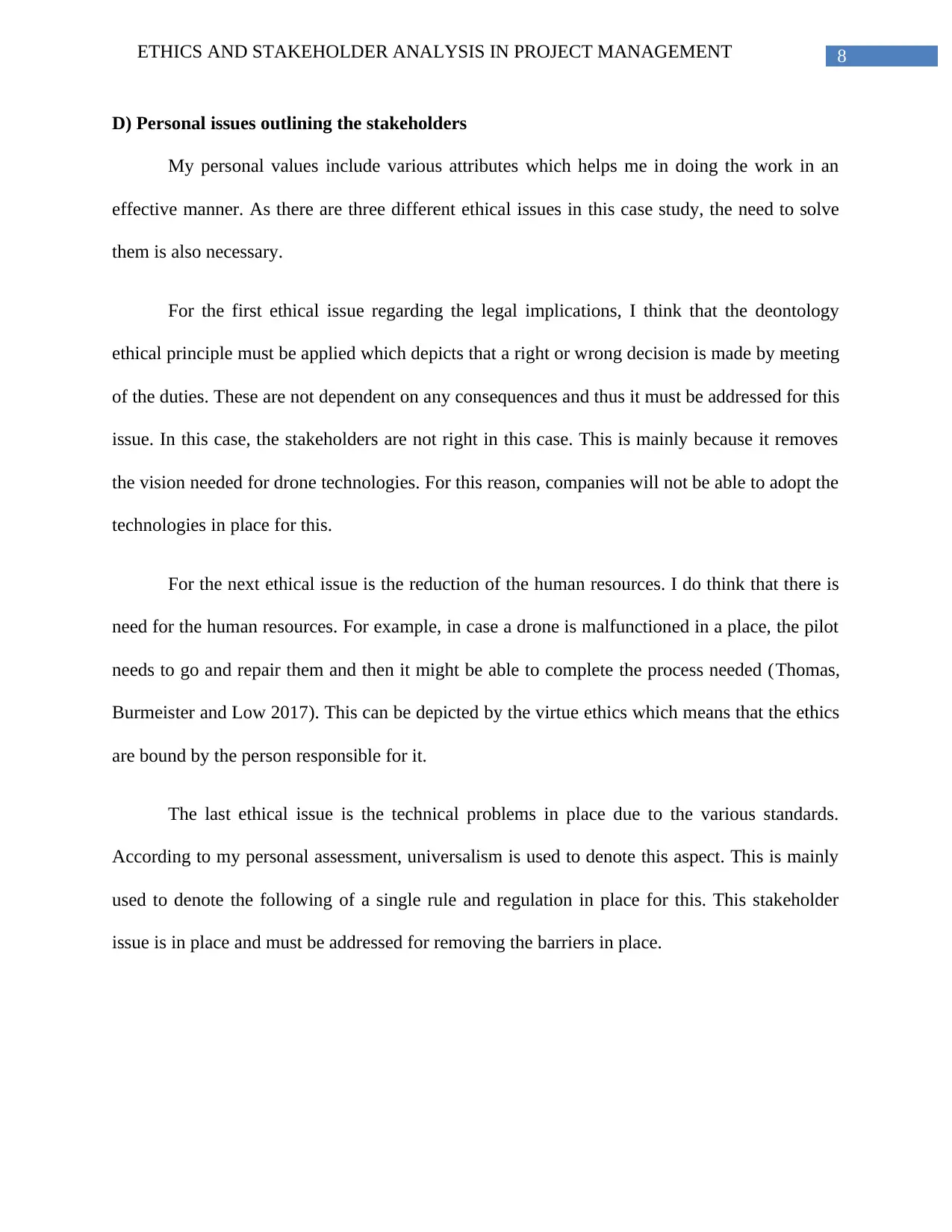
8ETHICS AND STAKEHOLDER ANALYSIS IN PROJECT MANAGEMENT
D) Personal issues outlining the stakeholders
My personal values include various attributes which helps me in doing the work in an
effective manner. As there are three different ethical issues in this case study, the need to solve
them is also necessary.
For the first ethical issue regarding the legal implications, I think that the deontology
ethical principle must be applied which depicts that a right or wrong decision is made by meeting
of the duties. These are not dependent on any consequences and thus it must be addressed for this
issue. In this case, the stakeholders are not right in this case. This is mainly because it removes
the vision needed for drone technologies. For this reason, companies will not be able to adopt the
technologies in place for this.
For the next ethical issue is the reduction of the human resources. I do think that there is
need for the human resources. For example, in case a drone is malfunctioned in a place, the pilot
needs to go and repair them and then it might be able to complete the process needed (Thomas,
Burmeister and Low 2017). This can be depicted by the virtue ethics which means that the ethics
are bound by the person responsible for it.
The last ethical issue is the technical problems in place due to the various standards.
According to my personal assessment, universalism is used to denote this aspect. This is mainly
used to denote the following of a single rule and regulation in place for this. This stakeholder
issue is in place and must be addressed for removing the barriers in place.
D) Personal issues outlining the stakeholders
My personal values include various attributes which helps me in doing the work in an
effective manner. As there are three different ethical issues in this case study, the need to solve
them is also necessary.
For the first ethical issue regarding the legal implications, I think that the deontology
ethical principle must be applied which depicts that a right or wrong decision is made by meeting
of the duties. These are not dependent on any consequences and thus it must be addressed for this
issue. In this case, the stakeholders are not right in this case. This is mainly because it removes
the vision needed for drone technologies. For this reason, companies will not be able to adopt the
technologies in place for this.
For the next ethical issue is the reduction of the human resources. I do think that there is
need for the human resources. For example, in case a drone is malfunctioned in a place, the pilot
needs to go and repair them and then it might be able to complete the process needed (Thomas,
Burmeister and Low 2017). This can be depicted by the virtue ethics which means that the ethics
are bound by the person responsible for it.
The last ethical issue is the technical problems in place due to the various standards.
According to my personal assessment, universalism is used to denote this aspect. This is mainly
used to denote the following of a single rule and regulation in place for this. This stakeholder
issue is in place and must be addressed for removing the barriers in place.
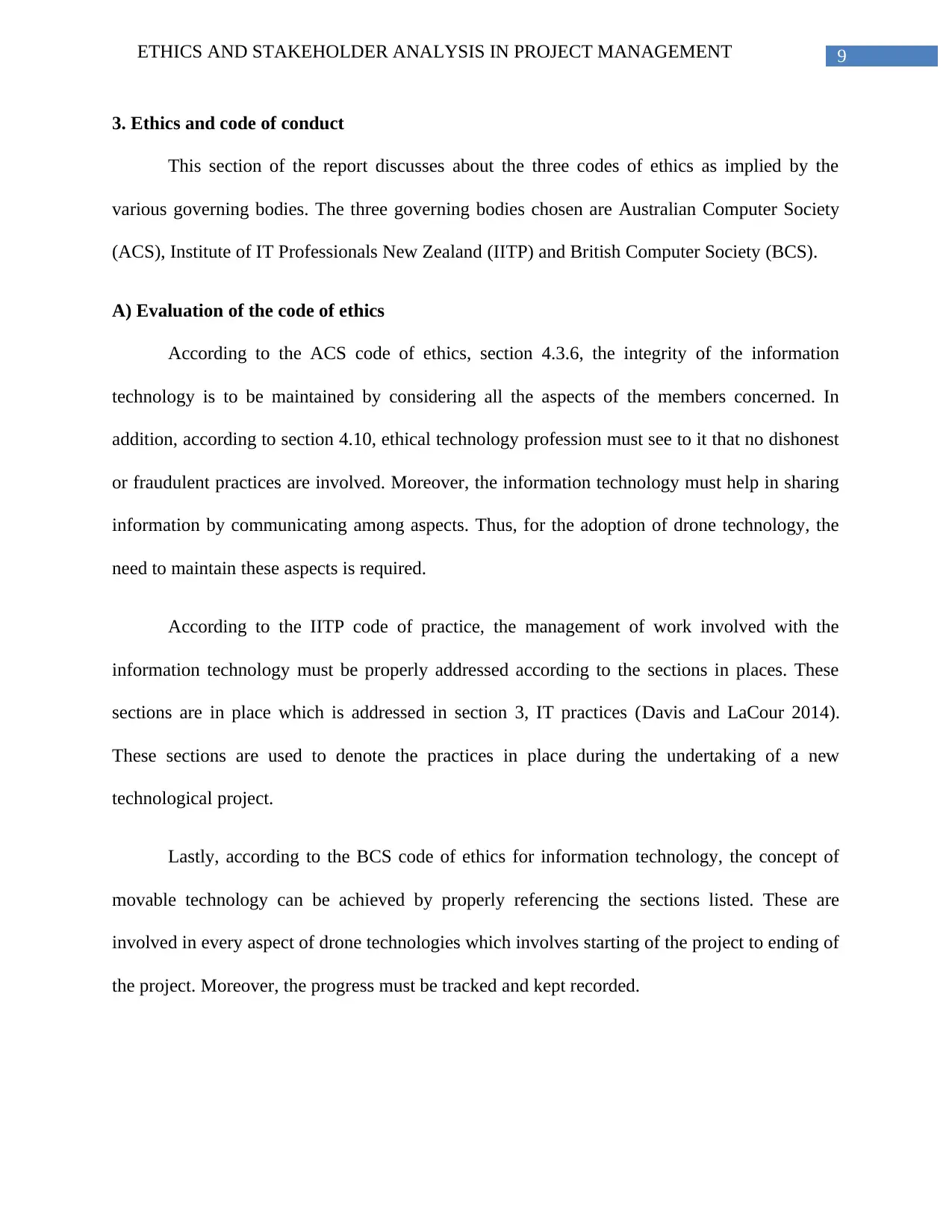
9ETHICS AND STAKEHOLDER ANALYSIS IN PROJECT MANAGEMENT
3. Ethics and code of conduct
This section of the report discusses about the three codes of ethics as implied by the
various governing bodies. The three governing bodies chosen are Australian Computer Society
(ACS), Institute of IT Professionals New Zealand (IITP) and British Computer Society (BCS).
A) Evaluation of the code of ethics
According to the ACS code of ethics, section 4.3.6, the integrity of the information
technology is to be maintained by considering all the aspects of the members concerned. In
addition, according to section 4.10, ethical technology profession must see to it that no dishonest
or fraudulent practices are involved. Moreover, the information technology must help in sharing
information by communicating among aspects. Thus, for the adoption of drone technology, the
need to maintain these aspects is required.
According to the IITP code of practice, the management of work involved with the
information technology must be properly addressed according to the sections in places. These
sections are in place which is addressed in section 3, IT practices (Davis and LaCour 2014).
These sections are used to denote the practices in place during the undertaking of a new
technological project.
Lastly, according to the BCS code of ethics for information technology, the concept of
movable technology can be achieved by properly referencing the sections listed. These are
involved in every aspect of drone technologies which involves starting of the project to ending of
the project. Moreover, the progress must be tracked and kept recorded.
3. Ethics and code of conduct
This section of the report discusses about the three codes of ethics as implied by the
various governing bodies. The three governing bodies chosen are Australian Computer Society
(ACS), Institute of IT Professionals New Zealand (IITP) and British Computer Society (BCS).
A) Evaluation of the code of ethics
According to the ACS code of ethics, section 4.3.6, the integrity of the information
technology is to be maintained by considering all the aspects of the members concerned. In
addition, according to section 4.10, ethical technology profession must see to it that no dishonest
or fraudulent practices are involved. Moreover, the information technology must help in sharing
information by communicating among aspects. Thus, for the adoption of drone technology, the
need to maintain these aspects is required.
According to the IITP code of practice, the management of work involved with the
information technology must be properly addressed according to the sections in places. These
sections are in place which is addressed in section 3, IT practices (Davis and LaCour 2014).
These sections are used to denote the practices in place during the undertaking of a new
technological project.
Lastly, according to the BCS code of ethics for information technology, the concept of
movable technology can be achieved by properly referencing the sections listed. These are
involved in every aspect of drone technologies which involves starting of the project to ending of
the project. Moreover, the progress must be tracked and kept recorded.
Secure Best Marks with AI Grader
Need help grading? Try our AI Grader for instant feedback on your assignments.
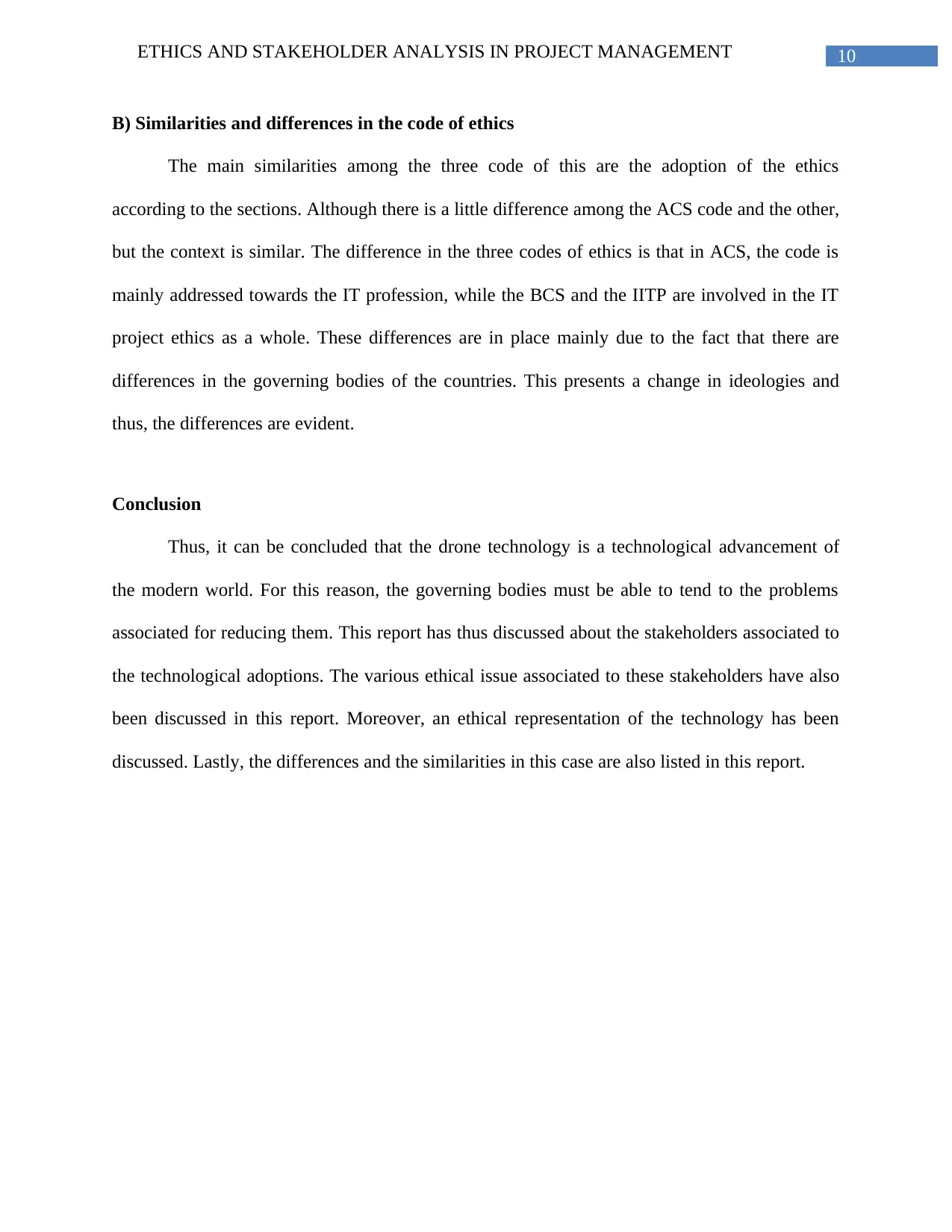
10ETHICS AND STAKEHOLDER ANALYSIS IN PROJECT MANAGEMENT
B) Similarities and differences in the code of ethics
The main similarities among the three code of this are the adoption of the ethics
according to the sections. Although there is a little difference among the ACS code and the other,
but the context is similar. The difference in the three codes of ethics is that in ACS, the code is
mainly addressed towards the IT profession, while the BCS and the IITP are involved in the IT
project ethics as a whole. These differences are in place mainly due to the fact that there are
differences in the governing bodies of the countries. This presents a change in ideologies and
thus, the differences are evident.
Conclusion
Thus, it can be concluded that the drone technology is a technological advancement of
the modern world. For this reason, the governing bodies must be able to tend to the problems
associated for reducing them. This report has thus discussed about the stakeholders associated to
the technological adoptions. The various ethical issue associated to these stakeholders have also
been discussed in this report. Moreover, an ethical representation of the technology has been
discussed. Lastly, the differences and the similarities in this case are also listed in this report.
B) Similarities and differences in the code of ethics
The main similarities among the three code of this are the adoption of the ethics
according to the sections. Although there is a little difference among the ACS code and the other,
but the context is similar. The difference in the three codes of ethics is that in ACS, the code is
mainly addressed towards the IT profession, while the BCS and the IITP are involved in the IT
project ethics as a whole. These differences are in place mainly due to the fact that there are
differences in the governing bodies of the countries. This presents a change in ideologies and
thus, the differences are evident.
Conclusion
Thus, it can be concluded that the drone technology is a technological advancement of
the modern world. For this reason, the governing bodies must be able to tend to the problems
associated for reducing them. This report has thus discussed about the stakeholders associated to
the technological adoptions. The various ethical issue associated to these stakeholders have also
been discussed in this report. Moreover, an ethical representation of the technology has been
discussed. Lastly, the differences and the similarities in this case are also listed in this report.
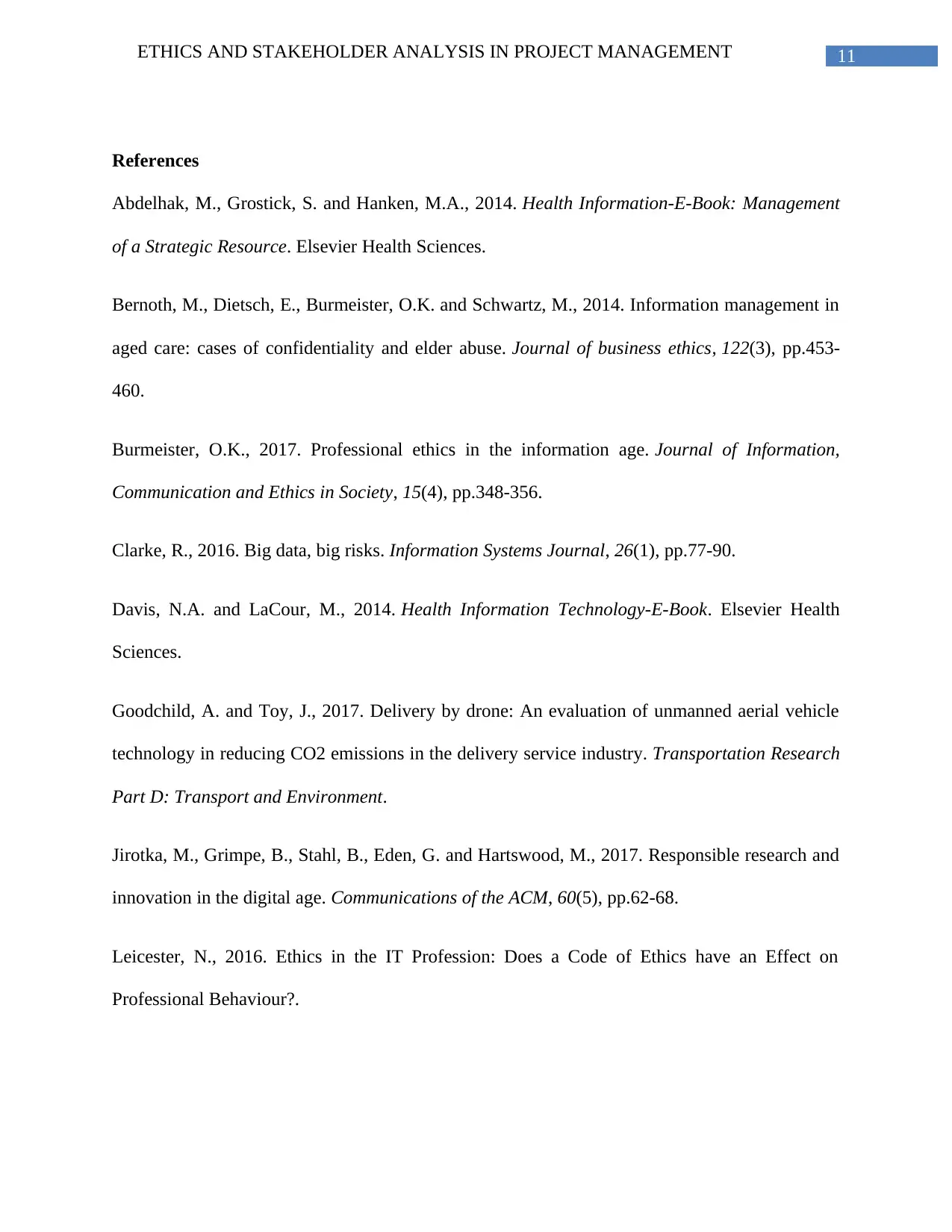
11ETHICS AND STAKEHOLDER ANALYSIS IN PROJECT MANAGEMENT
References
Abdelhak, M., Grostick, S. and Hanken, M.A., 2014. Health Information-E-Book: Management
of a Strategic Resource. Elsevier Health Sciences.
Bernoth, M., Dietsch, E., Burmeister, O.K. and Schwartz, M., 2014. Information management in
aged care: cases of confidentiality and elder abuse. Journal of business ethics, 122(3), pp.453-
460.
Burmeister, O.K., 2017. Professional ethics in the information age. Journal of Information,
Communication and Ethics in Society, 15(4), pp.348-356.
Clarke, R., 2016. Big data, big risks. Information Systems Journal, 26(1), pp.77-90.
Davis, N.A. and LaCour, M., 2014. Health Information Technology-E-Book. Elsevier Health
Sciences.
Goodchild, A. and Toy, J., 2017. Delivery by drone: An evaluation of unmanned aerial vehicle
technology in reducing CO2 emissions in the delivery service industry. Transportation Research
Part D: Transport and Environment.
Jirotka, M., Grimpe, B., Stahl, B., Eden, G. and Hartswood, M., 2017. Responsible research and
innovation in the digital age. Communications of the ACM, 60(5), pp.62-68.
Leicester, N., 2016. Ethics in the IT Profession: Does a Code of Ethics have an Effect on
Professional Behaviour?.
References
Abdelhak, M., Grostick, S. and Hanken, M.A., 2014. Health Information-E-Book: Management
of a Strategic Resource. Elsevier Health Sciences.
Bernoth, M., Dietsch, E., Burmeister, O.K. and Schwartz, M., 2014. Information management in
aged care: cases of confidentiality and elder abuse. Journal of business ethics, 122(3), pp.453-
460.
Burmeister, O.K., 2017. Professional ethics in the information age. Journal of Information,
Communication and Ethics in Society, 15(4), pp.348-356.
Clarke, R., 2016. Big data, big risks. Information Systems Journal, 26(1), pp.77-90.
Davis, N.A. and LaCour, M., 2014. Health Information Technology-E-Book. Elsevier Health
Sciences.
Goodchild, A. and Toy, J., 2017. Delivery by drone: An evaluation of unmanned aerial vehicle
technology in reducing CO2 emissions in the delivery service industry. Transportation Research
Part D: Transport and Environment.
Jirotka, M., Grimpe, B., Stahl, B., Eden, G. and Hartswood, M., 2017. Responsible research and
innovation in the digital age. Communications of the ACM, 60(5), pp.62-68.
Leicester, N., 2016. Ethics in the IT Profession: Does a Code of Ethics have an Effect on
Professional Behaviour?.
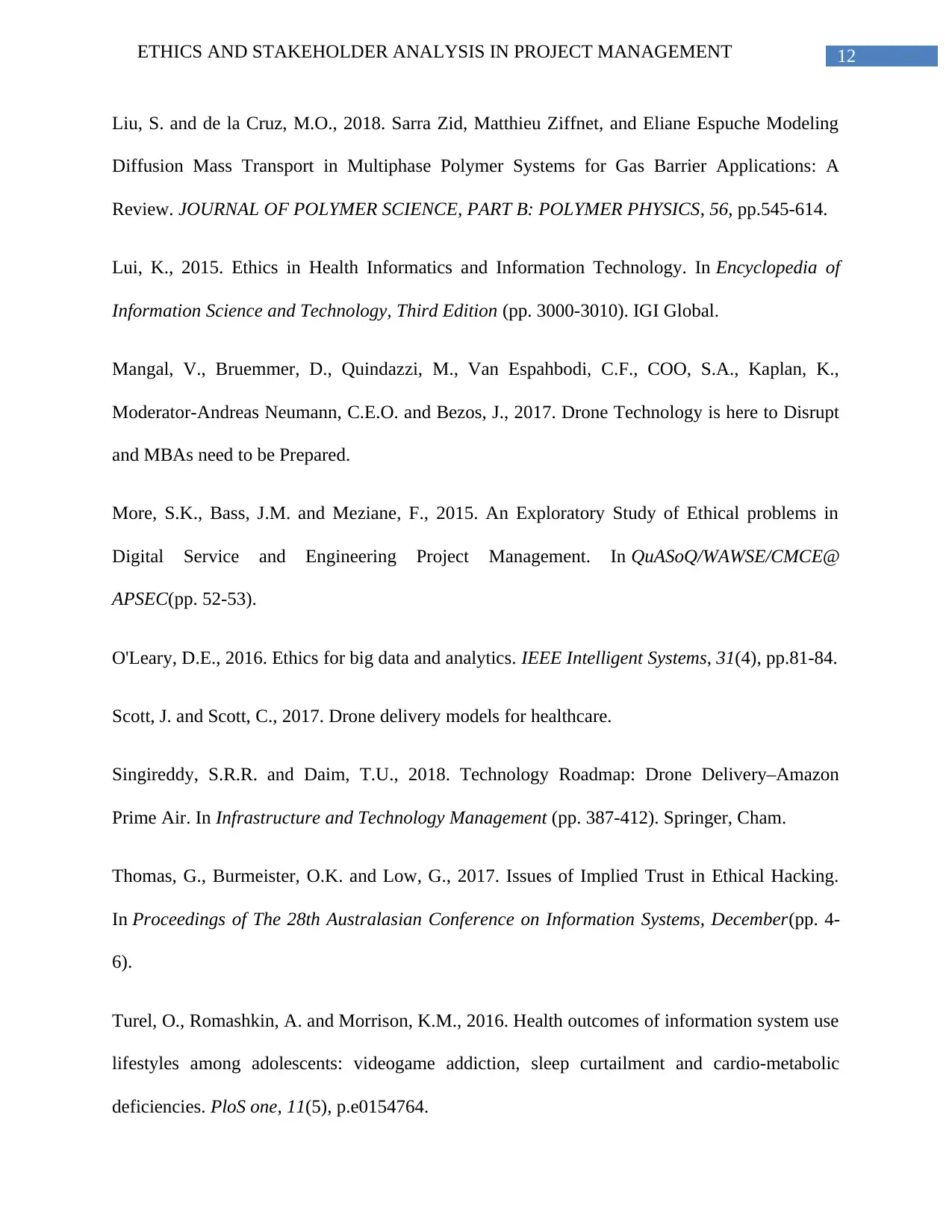
12ETHICS AND STAKEHOLDER ANALYSIS IN PROJECT MANAGEMENT
Liu, S. and de la Cruz, M.O., 2018. Sarra Zid, Matthieu Ziffnet, and Eliane Espuche Modeling
Diffusion Mass Transport in Multiphase Polymer Systems for Gas Barrier Applications: A
Review. JOURNAL OF POLYMER SCIENCE, PART B: POLYMER PHYSICS, 56, pp.545-614.
Lui, K., 2015. Ethics in Health Informatics and Information Technology. In Encyclopedia of
Information Science and Technology, Third Edition (pp. 3000-3010). IGI Global.
Mangal, V., Bruemmer, D., Quindazzi, M., Van Espahbodi, C.F., COO, S.A., Kaplan, K.,
Moderator-Andreas Neumann, C.E.O. and Bezos, J., 2017. Drone Technology is here to Disrupt
and MBAs need to be Prepared.
More, S.K., Bass, J.M. and Meziane, F., 2015. An Exploratory Study of Ethical problems in
Digital Service and Engineering Project Management. In QuASoQ/WAWSE/CMCE@
APSEC(pp. 52-53).
O'Leary, D.E., 2016. Ethics for big data and analytics. IEEE Intelligent Systems, 31(4), pp.81-84.
Scott, J. and Scott, C., 2017. Drone delivery models for healthcare.
Singireddy, S.R.R. and Daim, T.U., 2018. Technology Roadmap: Drone Delivery–Amazon
Prime Air. In Infrastructure and Technology Management (pp. 387-412). Springer, Cham.
Thomas, G., Burmeister, O.K. and Low, G., 2017. Issues of Implied Trust in Ethical Hacking.
In Proceedings of The 28th Australasian Conference on Information Systems, December(pp. 4-
6).
Turel, O., Romashkin, A. and Morrison, K.M., 2016. Health outcomes of information system use
lifestyles among adolescents: videogame addiction, sleep curtailment and cardio-metabolic
deficiencies. PloS one, 11(5), p.e0154764.
Liu, S. and de la Cruz, M.O., 2018. Sarra Zid, Matthieu Ziffnet, and Eliane Espuche Modeling
Diffusion Mass Transport in Multiphase Polymer Systems for Gas Barrier Applications: A
Review. JOURNAL OF POLYMER SCIENCE, PART B: POLYMER PHYSICS, 56, pp.545-614.
Lui, K., 2015. Ethics in Health Informatics and Information Technology. In Encyclopedia of
Information Science and Technology, Third Edition (pp. 3000-3010). IGI Global.
Mangal, V., Bruemmer, D., Quindazzi, M., Van Espahbodi, C.F., COO, S.A., Kaplan, K.,
Moderator-Andreas Neumann, C.E.O. and Bezos, J., 2017. Drone Technology is here to Disrupt
and MBAs need to be Prepared.
More, S.K., Bass, J.M. and Meziane, F., 2015. An Exploratory Study of Ethical problems in
Digital Service and Engineering Project Management. In QuASoQ/WAWSE/CMCE@
APSEC(pp. 52-53).
O'Leary, D.E., 2016. Ethics for big data and analytics. IEEE Intelligent Systems, 31(4), pp.81-84.
Scott, J. and Scott, C., 2017. Drone delivery models for healthcare.
Singireddy, S.R.R. and Daim, T.U., 2018. Technology Roadmap: Drone Delivery–Amazon
Prime Air. In Infrastructure and Technology Management (pp. 387-412). Springer, Cham.
Thomas, G., Burmeister, O.K. and Low, G., 2017. Issues of Implied Trust in Ethical Hacking.
In Proceedings of The 28th Australasian Conference on Information Systems, December(pp. 4-
6).
Turel, O., Romashkin, A. and Morrison, K.M., 2016. Health outcomes of information system use
lifestyles among adolescents: videogame addiction, sleep curtailment and cardio-metabolic
deficiencies. PloS one, 11(5), p.e0154764.
Paraphrase This Document
Need a fresh take? Get an instant paraphrase of this document with our AI Paraphraser

13ETHICS AND STAKEHOLDER ANALYSIS IN PROJECT MANAGEMENT
1 out of 14
Related Documents
Your All-in-One AI-Powered Toolkit for Academic Success.
+13062052269
info@desklib.com
Available 24*7 on WhatsApp / Email
![[object Object]](/_next/static/media/star-bottom.7253800d.svg)
Unlock your academic potential
© 2024 | Zucol Services PVT LTD | All rights reserved.





